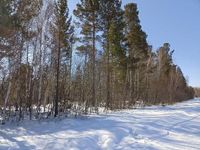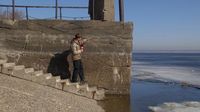The weather forecast for Angarsk for the weekend of March 29 and March 30, 2025, indicates variable cloudiness with light, intermittent precipitation in the form of wet snow and snow. The wind will be westerly and northwesterly at speeds of 5-10 m/s, with gusts potentially reaching 14 m/s. Nighttime temperatures are expected to drop between -2 and -7 degrees Celsius, while in clearings, temperatures could plummet to -12 to -17 degrees Celsius. In the northeastern regions, the mercury might dip even lower, ranging from -24 to -29 degrees Celsius. Daytime highs will range from +2 to +7 degrees Celsius, but will drop to between -1 and -6 degrees Celsius under cloudy conditions.
For Angarsk, the forecast for the next 24 hours also includes variable cloudiness with snow overnight and wet snow during the day. The northwesterly wind will blow at 4-9 m/s at night and increase to 7-12 m/s during the day. Nighttime temperatures will hover between -3 and -5 degrees Celsius, while daytime temperatures will range from +3 to +5 degrees Celsius.
On March 30, 2025, variable cloudiness will persist with light, intermittent precipitation in the form of snow and wet snow. The western, central, and southern regions are expected to experience light precipitation. The wind will again be westerly and northwesterly at speeds of 5-10 m/s, with gusts reaching 15 m/s during the day. Nighttime temperatures will range from 0 to -5 degrees Celsius, dropping to between -10 and -15 degrees Celsius in clearings. Daytime highs are predicted to be between +3 and +8 degrees Celsius, while in low-lying areas, temperatures may range from -2 to -7 degrees Celsius.
Folk omens for March 29 suggest that if it is warm on Savvin's day, then spring will be warm. Additionally, quick-moving and high-flying clouds are seen as a sign of good weather. Another saying indicates that if the sun sets in the clouds, rain is on the way.
For March 30, folk wisdom states that if it snows or rains, summer will be fruitful. Conversely, if the day is clear, summer might turn out to be hot and unfruitful for mushrooms and berries. A warm March 30 is thought to predict a similarly warm spring.
Meanwhile, the Volga River is experiencing significant shallowing, a situation that has been reported by residents across many regions of Russia. The Yaroslavl region is facing the most severe conditions, where a lack of water in the river has led to discussions about potentially suspending operations at hydroelectric power stations. This has raised concerns about shipping difficulties, prompting the introduction of an "orange level" weather hazard.
In the Ulyanovsk region, the Volga is also showing signs of shallowing, though not as drastically as in Yaroslavl. Local reporter Anton Kuzmin noted that the Yurmansky Bay now resembles a wide beach, where water once flowed. The Volga's annual shallowing is alarming, and assessments indicate that the river's current level is about one to two meters lower than normal.
The root cause of this troubling trend lies in the unusually warm winter experienced across much of European Russia, which has been recorded as one of the warmest in history. Additionally, winter precipitation levels have been significantly below average. If the upcoming spring does not bring substantial rainfall, the Volga's situation will likely worsen.
Significant shallowing of the river could have dire consequences for tourism and the economy. As trade routes pivot towards the East, the Volga has regained importance as a transportation artery, and there are already predictions of shipping difficulties in the river's upper reaches. The fish industry is also at risk, as low water levels reduce the habitats available for fish to spawn and thrive.
March is typically the start of the fishing season in Astrakhan, but this year, the Ministry of Agriculture has imposed a ban on both commercial and recreational fishing of the bream. The fluctuations in water levels will also impact other wildlife, including birds and amphibians. Ornithologist Maxim Korolkov pointed out that species such as the little tern and the black-winged pratincole, which nest in sandy shallows, are now at risk due to the changing water levels.
Environmental expert Lev Levitas warned that decreased water levels will lead to higher concentrations of harmful substances from runoff, particularly as untreated stormwater continues to flow into waterways. Despite a court ruling in 2007 prohibiting such dumping, the city has failed to comply, incurring fines each year.
The Volga's water management system, which includes a series of dams, allows for water conservation or release based on decisions made by a working group. The next meeting is slated for early April, where further discussions on managing the river's water levels will take place.
In light of the current weather patterns, Roshydromet has reported high water content throughout the Volga-Kama cascade, but forecasts for the second quarter predict low water levels. April is expected to be relatively dry, raising concerns about the implications of shallow water on both economic and ecological fronts.





